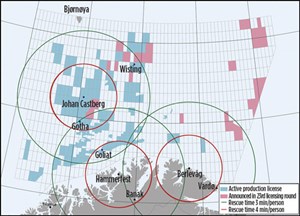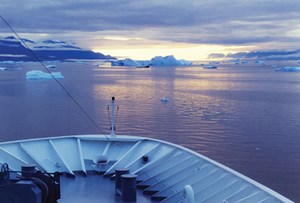Barents Sea safety and rescue capabilities assessed
Conditions in the Barents Sea are more favorable for offshore activities than in other Arctic areas. However, challenges—such as cold temperatures, icing, sea ice, lasting periods of darkness and a lack of offshore supporting infrastructure—need to be addressed to achieve safe operations. Identifying hazards allows risk-reducing measures to be implemented, for example, winterization or ice management systems.
EVACUATION CAPABILITIES
DNV GL’s position paper, Emergency response for offshore operations in the Barents Sea, examines evacuation and rescue capabilities in the area. The performance limits of resources available have been compared to the prevailing conditions in the Barents Sea, based on equipment already in use farther south on the Norwegian Continental Shelf (NCS).
Freefall lifeboats and rescue crafts are readily available for most of the year. However, life rafts, escape chutes and man-overboard boats are more affected by wind and waves, and their availability is considerably reduced (<75%) in poorer weather. Still, the availability levels are comparable to those in the Norwegian Sea. The presence of sea ice is the main factor limiting the availability of the response resources. Thus, equipment for monitoring and tracking sea ice should be installed to identify situations, where evacuation might no longer be possible. In those cases, preventive down-manning might become necessary.
LONG-RANGE RESCUE CAPABILITY
The position paper also addresses long-range rescue capability. As there is no existing offshore infrastructure, operations in the Barents Sea rely upon emergency response vessels in the vicinity of the installation, and onshore resources. Emergency response vessels can support both evacuation and rescue, but they are limited by speed. Helicopters with search and rescue capabilities are required for situations that involve travelling long distances within a short period of time.

Recommendations for planning the rescue time of personnel assume 3 min. for locating and rescuing one person from the sea with a helicopter. This is dependent on daylight and sea state: the estimate should be increased to 4 min. in darkness, and with a significant wave height exceeding 6 m. This could have a considerable impact on long-range rescue capability during the winter months.
While helicopters based onshore can provide sufficient rescue capacity for the southwestern part of the Barents Sea, response capabilities further offshore are limited, due to a lack of offshore infrastructure, Fig. 1. As a consequence, new response concepts are needed for operations in the most remote locations.
COST, CONCERN AND COLLABORATION
While emergency preparedness and response capabilities are important factors to increasing safety levels, they also raise the investment and operational costs of offshore installations.
To support the development of concepts for emergency preparedness and response in the Barents Sea, DNV GL is initiating a new Joint Industry Project (JIP) on the Qualification of Arctic Emergency Response Concepts. The JIP is planned in two phases. The first phase evaluates existing evacuation and rescue resources. The second phase focuses on the development and evaluation of site-specific emergency response concepts. This includes the development of a methodology for assessing the trade-off between cost and performance of the concept.
The economic assessment will analyze the effect of sharing resources and cooperation between different installations to reduce the cost. It also will examine the size of the areas for which different shared resources can contribute to the achieved preparedness level.
The challenges of operating in the Barents Sea (Fig. 2) are well-documented, but there is no definitive answer yet, as to how these emergency preparedness challenges should be addressed. The development of joint emergency response concepts, based on similar principles to those used farther south on the NCS, can be an important step toward safe and sustainable offshore operations in the region. ![]()
- Advancing offshore decarbonization through electrification of FPSOs (March 2024)
- The reserves replacement dilemma: Can intelligent digital technologies fill the supply gap? (March 2024)
- What's new in production (February 2024)
- Subsea technology- Corrosion monitoring: From failure to success (February 2024)
- U.S. operators reduce activity as crude prices plunge (February 2024)
- U.S. producing gas wells increase despite low prices (February 2024)



